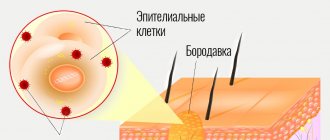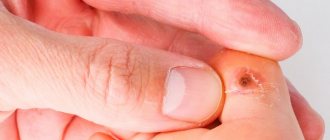Plantar wart removal price
The cost of removing plantar warts in Moscow can vary and reach several thousand rubles.
Before removing the spine, you need to clarify the cost of the manipulation. Many clinics indicate a low cost in their price list. Most often, this means that the true price is veiled and at the appointment it turns out that you need to pay extra for anesthesia, bandaging, etc.
In our clinic, the price list indicates the full price of the intervention, i.e. no additional payments will be required.
Features, symptoms of plantar warts
The spine is a compaction on the plantar surface of the foot with a diameter of 2 to 10 mm (sometimes more). The formation resembles a small callus, which can be either flush with the skin or slightly raised above it. The presence of microscopic dark spots on the surface (thrombosed capillaries) is considered characteristic. Color – from white-yellow to brown. The wart is dense to the touch, pressing on it causes pain.
The spine differs from ordinary warts and papillomas in its higher density, as well as pain when pressed. This is due to the fact that, due to their location, they are always subject to pressure and stress, which causes them to become keratinized; in appearance they sometimes resemble small calluses. The same factor causes pain - when pressed, a dense wart presses on deeper tissues, causing pain (a comparison with a pebble in a shoe is appropriate here).
Removal of plantar warts should be carried out by a specialist. Attempts at self-removal, as well as treatment with folk remedies, are usually ineffective, because the spines are highly dense and have deep “roots.” Superficial removal (cutting with forceps after steaming, applying celandine, aloe, etc.) usually leads to relapse.
Flat, thread-like, pointed...
Warts are caused by several types of viruses. Especially common is the one that “grows” ordinary, simple warts
.
These are small (2-10 mm in diameter), dense benign tumors with clear boundaries, an uneven surface, round or irregular in shape, light gray, yellow, brown or grayish-black. Most often they appear in places prone to trauma (for example, on the fingers, elbows, knees, scalp), but they can also appear in other areas of the body. Plantar warts
, as their name suggests, occur on the soles of the feet.
Because the soles are a place of constant friction, plantar warts can be quite painful; They can be distinguished from calluses by the tiny, pinprick-like drops of blood that appear when you cut off the top of the wart. Filiform warts - small, long and narrow growths - usually form on the eyelids, face, neck, and lips. Flat (juvenile) warts
- smooth, flat, yellowish-brown nodules - are usually found on the face and along scratch marks, most often in children and young people.
There are also warts with unusual shapes, such as pedunculated or cauliflower-shaped warts, most often occurring on the head and neck. Genital warts
(condylomas) affect the external genitalia of men and women. They look like small soft and moist bubbles of pink and red color. They grow quickly, and at the same time a narrow stalk can form at the base.
Reasons for appearance
As mentioned above, the main cause of warts is the human papillomavirus (HPV). The presence of HPV in the body is quite common. But the mere fact of the presence of a virus does not necessarily mean the appearance of papillomas.
Predisposing factors are:
- Poor foot hygiene
- Sweaty feet
- Skin trauma - abrasions, microcracks
- High virus activity
- Certain types of virus
- Decreased antiviral immunity
- Some common diseases that reduce the trophism (nutrition) of the skin of the foot are diabetes mellitus, polyneuropathy, arterial atherosclerosis
There are many types of human papillomavirus. Some of its varieties can cause the development of malignant tumors. The virus that causes plantar warts is not one of them. Spines never become malignant, but can cause other inconveniences - pain, cosmetic defects.
Anyone can have the virus...
The virus enters the body through the skin or mucous membrane, then “follows” the subepithelial layer and penetrates the nervous tissue. Done: now the virus is your property for life and its location explains the connection between skin rashes and the state of the nervous system: for a wart to materialize, any nervous shock, fear, frustration, excitement or self-hypnosis is enough: “What if they appear!?” Then they will definitely appear. It’s just that many people are affected by viruses, but for the time being they don’t know about it. The virus can “sleep” without causing harm. It can “travel” along nerve pathways inside the body and even settle harmlessly, for example, in the spinal cord. But as soon as you get more excited, he always turns out to be ready to make his way back to the skin and reward the owner with “decoration”.
Removal of plantar warts
Peculiarities
When removing spines, you need to consider the following features:
1. Location on the sole increases the wound healing time (due to constant mechanical impact, sweating, etc.).
2. They are always removed deeply, forming a “crater”. Superficial removal is fraught with the risk of leaving the “roots” of the wart and recurrence.
3. “Home treatment” with folk remedies is undesirable, because with it, it is not possible to achieve the optimal depth of exposure, or, on the contrary, extensive chemical burns occur with various substances used for these purposes.
What to do if warts bleed
The main causes of bleeding warts can be:
- the development of complications caused by the degeneration of a wart into a malignant form;
- mechanical damage to the formation.
Cases when papilloma degenerates into a malignant formation (melanoma) are extremely rare. But if the wart bleeds for no apparent reason, you should immediately consult a doctor.
Especially if the process is accompanied by a sharp change in the color and size of the formation, as well as the appearance of pain. In this case, a qualified specialist should make a diagnosis and prescribe appropriate treatment. Damage to the papilloma often leads to the release of blood, which is directly related to the specific structure of this neoplasm.
A wart is the result of the proliferation of epidermal tissues, which, under the influence of a virus, are modified and create formations atypical for healthy cells - papules. Inside them, new capillary vessels are formed, which are easily damaged by mechanical irritation of the warts.
As a result, the tumor may bleed.
This often occurs when papillomas are localized in areas of the body that are subject to frequent mechanical stress. Typically these are the feet and hands, inner thighs and perineal area.
By the way, one of the reasons for bleeding from the vagina, especially after sexual intercourse, may be damage to warts (condylomas) formed in it.
Methods
There are several methods for removing spines. They all boil down to the destruction of the wart, but this is achieved through various methods of influence, which can be divided into three groups:
- Destruction (destruction using laser, radio waves, electrocoagulation)
- Chemical destruction using various substances (liquid nitrogen, salicylic acid, alkalis, etc.)
- Surgical excision
Let's take a closer look at these methods
Destruction methods are the most effective, because they destroy the wart completely and with high precision. The radio wave method should be considered the most optimal. It involves the most gentle and at the same time deep removal of the spine. During laser removal, the depth of penetration may not be sufficient to destroy the “roots” of the wart, which can lead to recurrence. When removed with an electrocoagulator, excessive damage to surrounding tissue occurs, which leads to longer wound healing and the formation of a rougher scar.
Chemical destruction is not very effective in treating plantar warts, but is more suitable for removing small papillomas on other parts of the body (i.e. those small formations that rise above the surface of the skin). Plantar warts are located almost flush with the skin and spread quite deeply inward. Therefore, the effect of a chemical on them is either not enough to completely destroy the wart, or, on the contrary, it is too extensive and causes chemical burns of the surrounding tissues, sometimes with the formation of long-term non-healing ulcers.
Surgical excision is rarely used for two reasons: firstly, extensive excision involving healthy tissue is simply not necessary and unreasonably increases the volume and invasiveness of the intervention. Secondly, the plantar surface of the foot is subject to constant mechanical stress (plus sweat production, limited “ventilation” of the wound due to shoes). All this greatly increases the risk of suppuration under the sutures. Surgical removal is advisable in cases where the wart is suspicious of a malignant formation and a high-quality histological (under a microscope) examination of the removed material is required.
How to treat warts
Answering the question in the title of the article, we will say: you need to remove warts, but only as prescribed by a doctor. In no case on your own! In some cases, removal is contraindicated, so be examined before making a decision.
In modern medicine, warts are safely removed using surgery, electric current, laser or liquid nitrogen. Such procedures do not leave serious scars on the skin and help quickly get rid of papillomas. At the same time, the patient is prescribed specially selected antiviral and immunomodulatory therapy, which helps suppress the HPV outbreak and significantly increase immunity.
If the wart is small in size, does not grow and does not interfere with the natural movement of the body, then you can try to cure it with special ointments. Treatment takes a lot of time and is always discussed between the doctor and the patient during the examination.
Also, every patient should understand that today there are no medications or procedures that can permanently rid the body of HPV. No one is immune from relapses. But you can suppress the influence of HPV with the help of a healthy lifestyle, increasing the body’s immune functions, hygiene and barrier contraception.
How does the removal itself take place?
At the appointment, the doctor clarifies complaints, the duration of the disease, conducts an examination, and clarifies the presence of concomitant diseases and allergies to medications.
If the diagnosis is confirmed and there are no contraindications, intervention is performed. After treating the skin with an antiseptic, local anesthesia is administered with a thin needle. This may cause some pain (like any injection), but then the removal itself is completely painless. After making sure that the anesthetic has worked, the doctor destroys the wart with a radio wave scalpel. After removal, the wound is treated with fucorcin and a bandage is applied. The entire intervention takes 2–3 minutes.
Beware of abrasions and cuts
You can “catch” the virus from a sick person through direct contact, for example, by shaking hands. Or through infected objects: toys, handrails in public transport. Two to three hours of virus life in the external environment is enough for someone to become infected: the infection is quite common. Factors predisposing to infection are sweating (which, by the way, also depends on the state of the nervous system) and microtraumas on the skin. Microtraumas always exist; they are inevitable during household work: washing, cooking, cleaning, and in children they occur even during such innocent activities as modeling from plasticine.
Where can a plantar wart be removed in Moscow?
We can definitely say that spines need to be removed in a clinical setting; the intervention should be carried out by a qualified surgeon who has extensive experience in treating such pathology. In Moscow, this can be done by Dr. Igor Vitalievich Elshansky. He will remove the formation using the optimal radio wave method. The intervention is painless, performed under local anesthesia, and after the manipulation the patient can immediately go home. The clinic has all the conditions for qualified removal.
Don’t expect the wart to “go away” on its own, don’t try to remove it yourself, contact a professional!
Contact your doctor if:
- if the wart is in the genital area;
- if the tumor itches or bleeds;
- if the wart has an uneven color;
- if it very quickly changes color, shape, or all together;
- if it hurts or is constantly injured (this increases the risk of its degeneration into something very serious);
- if their number begins to increase;
- if the boundaries of the neoplasm are blurred or you are not sure that it is a wart. The answer can only be given by an examination by a specialist.










